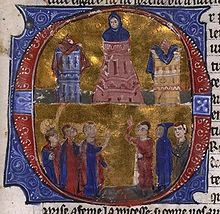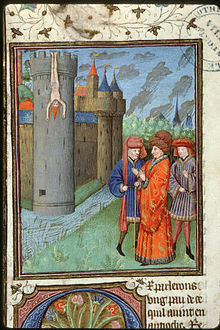
Aimery of Lusignan, erroneously referred to as Amalric or Amaury in earlier scholarship, was the first King of Cyprus, reigning from 1196 to his death. He also reigned as the King of Jerusalem from his marriage to Isabella I in 1197 to his death. He was a younger son of Hugh VIII of Lusignan, a nobleman in Poitou. After participating in a rebellion against Henry II of England in 1168, he went to the Holy Land and settled in the Kingdom of Jerusalem.

The Kingdom of Jerusalem, also known as the Latin Kingdom, was a Crusader state that was established in the Levant immediately after the First Crusade. It lasted for almost two hundred years, from the accession of Godfrey of Bouillon in 1099 until the fall of Acre in 1291. Its history is divided into two periods with a brief interruption in its existence, beginning with its collapse after the siege of Jerusalem in 1187 and its restoration after the Third Crusade in 1192.

William of Tyre was a medieval prelate and chronicler. As archbishop of Tyre, he is sometimes known as William II to distinguish him from his predecessor, William I, the Englishman, a former prior of the Church of the Holy Sepulchre, who was Archbishop of Tyre from 1127 to 1135. He grew up in Jerusalem at the height of the Kingdom of Jerusalem, which had been established in 1099 after the First Crusade, and he spent twenty years studying the liberal arts and canon law in the universities of Europe.

Baldwin IV of Jerusalem (1161–1185), known as the Leper King, was the king of Jerusalem, from 1174 until his death in 1185. He was admired by his contemporaries and later historians for his willpower and dedication to the Latin Kingdom in the face of debilitating leprosy. Choosing competent advisers, Baldwin ruled a thriving crusader state and succeeded in protecting it from the Muslim ruler Saladin.
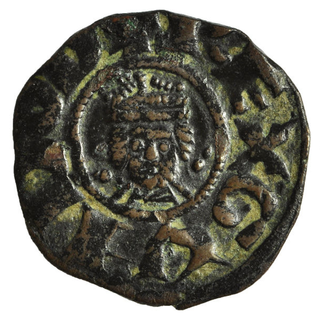
Guy of Lusignan was a French Poitevin knight who reigned as the king of Jerusalem from 1186 to 1192 by right of marriage to Sibylla, and King of Cyprus from 1192 to 1194.
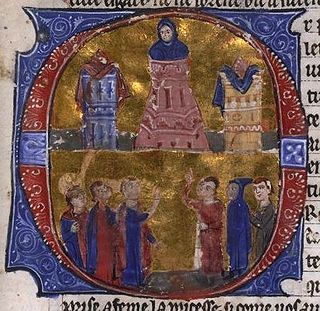
Raynald of Châtillon, also known as Reynald, Reginald, or Renaud, was Prince of Antioch—a crusader state in the Middle East—from 1153 to 1160 or 1161, and Lord of Oultrejordain—a large fiefdom in the crusader Kingdom of Jerusalem—from 1175 until his death, ruling both territories iure uxoris. The second son of a French noble family, he joined the Second Crusade in 1147, and settled in Jerusalem as a mercenary. Six years later, he married Constance, Princess of Antioch, although her subjects regarded the marriage as a mesalliance.

The Crusader states, or Outremer, were four Catholic polities that existed in the Levant from 1098 to 1291. Following the principles of feudalism, the foundation for these polities was laid by the First Crusade, which was proclaimed by the Latin Church in 1095 in order to reclaim the Holy Land after it was lost to the 7th-century Muslim conquest. Situated on the Eastern Mediterranean, the four states were, in order from north to south: the County of Edessa (1098–1150), the Principality of Antioch (1098–1268), the County of Tripoli (1102–1289), and the Kingdom of Jerusalem (1099–1291). The three northern states covered an area in what is now southeastern Turkey, northwestern Syria, and northern Lebanon; and the Kingdom of Jerusalem, the southernmost and most prominent state, covered an area in what is now Israel, Palestine, southern Lebanon, and western Jordan. The description "Crusader states" can be misleading, as from 1130 onwards, very few people among the Franks were Crusaders. Medieval and modern writers use the term "Outremer" as a synonym, derived from the French word for overseas.

The Principality of Antioch was one of the Crusader states created during the First Crusade which included parts of modern-day Turkey and Syria. The principality was much smaller than the County of Edessa or the Kingdom of Jerusalem. It extended around the northeastern edge of the Mediterranean, bordering the County of Tripoli to the south, Edessa to the east, and the Byzantine Empire or the Kingdom of Armenia to the northwest, depending on the date.
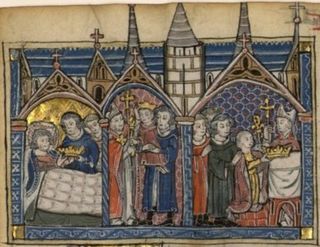
Raymond III was count of Tripoli from 1152 to 1187. He was a minor when Nizari Assassins murdered his father, Raymond II of Tripoli. Baldwin III of Jerusalem, who was staying in Tripoli, made Raymond's mother, Hodierna of Jerusalem, regent. Raymond spent the following years at the royal court in Jerusalem. He reached the age of majority in 1155, after which he participated in a series of military campaigns against Nur ad-Din, the Zengid ruler of Damascus. In 1161 he hired pirates to pillage the Byzantine coastline and islands to take vengeance on Byzantine emperor Manuel I Komnenos, who had refused to marry his sister Melisende. He was captured in the Battle of Harim by Nur ad-Din's troops on 10 August 1164, and imprisoned in Aleppo for almost ten years. During his captivity, Amalric I of Jerusalem administered the county of Tripoli on his behalf.

Sibylla was the queen of Jerusalem from 1186 to 1190. She reigned alongside her husband Guy of Lusignan, to whom she was unwaveringly attached despite his unpopularity among the barons of the Kingdom of Jerusalem.

Isabella I was reigning Queen of Jerusalem from 1190 to her death in 1205. She was the daughter of Amalric I of Jerusalem and his second wife Maria Comnena, a Byzantine princess. Her half-brother, Baldwin IV of Jerusalem, engaged her to Humphrey IV of Toron. Her mother's second husband, Balian of Ibelin, and his stepfather, Raynald of Châtillon, were influential members of the two baronial parties. The marriage of Isabella and Humphrey was celebrated in Kerak Castle in autumn 1183. Saladin, the Ayyubid sultan of Egypt and Syria, laid siege to the fortress during the wedding, but Baldwin IV forced him to lift the siege.
Constance of Hauteville (1128–1163) was the ruling princess of Antioch from 1130 to 1163. She was the only child of Bohemond II of Antioch and Alice of Jerusalem. Constance succeeded her father at the age of two after he fell in battle, although his cousin Roger II of Sicily laid claim to Antioch. Alice assumed the regency, but the Antiochene noblemen replaced her with her father, Baldwin II of Jerusalem. After he died in 1131, Alice again tried to take control of the government, but the Antiochene barons acknowledged the right of her brother-in-law Fulk of Anjou to rule as regent for Constance.

Bohemond III of Antioch, also known as Bohemond the Child or the Stammerer, was Prince of Antioch from 1163 to 1201. He was the elder son of Constance of Antioch and her first husband, Raymond of Poitiers. Bohemond ascended to the throne after the Antiochene noblemen dethroned his mother with the assistance of the lord of Armenian Cilicia, Thoros II. He fell into captivity in the Battle of Harim in 1164, but the victorious Nur ad-Din, atabeg of Aleppo released him to avoid coming into conflict with the Byzantine Empire. Bohemond went to Constantinople to pay homage to Manuel I Komnenos, who persuaded him to install a Greek Orthodox patriarch in Antioch. The Latin patriarch of Antioch, Aimery of Limoges, placed Antioch under interdict. Bohemond restored Aimery only after the Greek patriarch died during an earthquake in 1170.
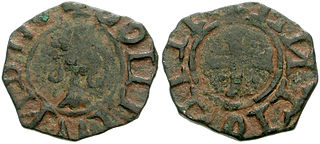
Bohemond IV of Antioch, also known as Bohemond the One-Eyed, was Count of Tripoli from 1187 to 1233, and Prince of Antioch from 1201 to 1216 and from 1219 to 1233. He was the younger son of Bohemond III of Antioch. The dying Raymond III of Tripoli offered his county to Bohemond's elder brother, Raymond, but their father sent Bohemond to Tripoli in late 1187. Saladin, the Ayyubid sultan of Egypt and Syria, conquered the county, save for the capital and two fortresses, in summer 1188.
The Treaty of Devol was an agreement made in 1108 between Bohemond I of Antioch and Byzantine Emperor Alexios I Komnenos, in the wake of the First Crusade. It is named after the Byzantine fortress of Devol. Although the treaty was not immediately enforced, it was intended to make the Principality of Antioch a vassal state of the Byzantine Empire.

Agnes of Courtenay was a Frankish noblewoman who held considerable influence in the Kingdom of Jerusalem during the reign of her son, King Baldwin IV. Though she was never queen, she has been described as the most powerful woman in the kingdom's history after Queen Melisende.

Maria of Antioch was a Byzantine empress by marriage to Byzantine Emperor Manuel I Komnenos, and regent during the minority of her son porphyrogennetos Alexios II Komnenos from 1180 until 1182.
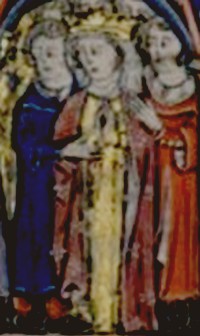
Theodora Komnene or Comnena was a niece of Byzantine emperor Manuel I Comnenus, and wife of King Baldwin III of Jerusalem.

Maria Komnene, Latinized Comnena, was the queen of Jerusalem from 1167 until 1174 as the second wife of King Amalric. She occupied a central position in the Kingdom of Jerusalem for twenty years, earning a reputation for intrigue and ruthlessness.

The timeline of the Kingdom of Jerusalem presents important events in the history of the Kingdom of Jerusalem—a Crusader state in modern day Israel and Jordan—in chronological order. The kingdom was established after the First Crusade in 1099. Its first ruler Godfrey of Bouillon did not take the title of king and swore fealty to the Latin Patriarch of Jerusalem, Daimbert. Godfrey's brother and successor Baldwin I was crowned the first king of Jerusalem without doing homage to the patriarch in 1100. By 1153, Baldwin I and his successors captured all towns on the Palestinian coast with the support of Pisan, Genoese and Venetian fleets and also took control of the caravan routes between Egypt and Syria. The kings regularly administered other crusader states—the Counties of Edessa and Tripoli and the Principality of Antioch—on behalf of their absent or underage rulers.

